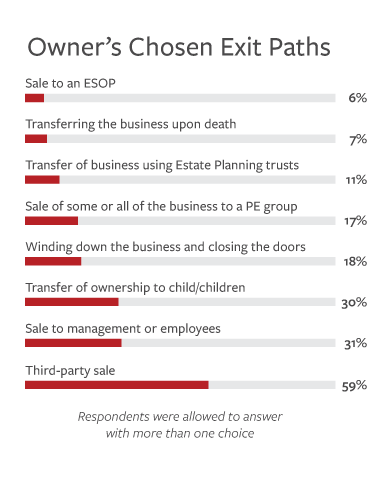By David Coit, VERTESS | August 2, 2017
A few months ago, I shared six tips for creating value in your business.
Here are six more best practices to keep in mind. These are useful for all owners, regardless of whether you’re looking toward a transaction in the near-term.
Check out the first six tips here, then read on for tips #7-12.
- Invest in HR
Company owners often underestimate the value of a having a human resources professional or (if your firm is large enough) a human resources department.
In fact, HR can create value for your company by increasing employee engagement, enhancing employee skill sets, improving employee morale, increasing employee commitment, and improving collaboration and teamwork results.
That, in turn, increases operating efficiencies, enhances customer value, lowers costs (especially employee replacement cost), creates greater creativity, and allows owners and managers to spend less time on employee problems.
Depending on your circumstances, an HR professional or unit can help you:
- Build employee brand equity
- Generate a culture that values teamwork
- Implement a mentoring program
- Engage Millennials more effectively
- Align employees to job positions via competency and personality trait matching
- Use social media to publicize employee achievements
- Match employee compensation/rewards to organizational goals
- Promote workforce diversity
- Advance employee wellness programs.
Most importantly, HR can help you recruit and retain top talent, which means faster growth. And companies that attract top talent become harder to compete against, which also creates company value.
- Avoid Commodity Hell
Let me introduce you to an important marketing concept: Commodity Hell. That’s where you end up when your segment of the business is so crowded with competitors that every product and service offering is virtually the same.
Commodity Hell always means price wars, because all other things being equal, price becomes the only differentiator between competitors. Price wars mean lower profits, where lower profits destroy the value of your company.
The classic case of Commodity Hell was the PC industry in the 1990s. Originally there were dozens of PC manufacturers, all of which were operating profitably. When Microsoft Windows became a standard, every manufacturer’s PC offering looked the same. Margins plummeted into the low single digits, and only a few huge vendors (like Dell) survived the carnage.
The only PC manufacturer that escaped, if not unscathed then at least positioned to grow, was Apple. Rather than follow the crowd into Commodity Hell, Apple differentiated its computers and created new products (iPod, iPhone, etc.) and services (iTunes). As a result, they became one of the most valuable companies in the world.
In the same way, companies can avoid Commodity Hell (and maintain and grow their financial value) by satisfying more of their customers/clients desires and needs than competitors do. The challenge (think Apple again) is knowing the difference between what customers say they want and what they really want, and even knowing what customers want before they know they want it.
For example, how many healthcare customers/clients knew they wanted remote monitoring 30 years ago? Or even ten years ago?
Here are some strategies that have worked in the past for our healthcare clients:
- Re-design products for simplicity, user-friendliness, cool-looking, performance, serviceability, and reliability
- Offer customers easy, anytime, anywhere access to relevant product/service related information
- Provide clients with online interactions through web portals, mobile devices, and social networks
- Allow customers access to the price of services (transparency)
- Provide customers with a telemedicine option for virtual client visits
- Build company/products/services branding
- Add complementary products and services that enhance client visits
- Design a client-centered facility/office that reduces customer stress and enhances the client’s experience
In our experience, the more a company differentiates its products and services from competitors, the more economic value it creates for the company and the better it can serve its customers.
- Create a Better Value Chain
Companies rely on third-party providers of materials, supplies, billing services, contract labor, etc. These providers are part of a “value chain.”
Too often, companies spend less time thinking about their value chain than other parts of their business. This is unfortunate because companies operate the most effectively and create the most value by creating a strong working relationship with value chain partners.
In my experience, the most successful companies focus on what they do best and rely on third party providers to meet other company/customer needs. To do this effectively, however, companies must stop thinking of third-party providers as purely a service providers but rather value-added partners in a value chain system. Taking a “value chain” perspective of your third-party providers requires you demand they:
- Provide just-in-time delivery of products and services.
- Be more timely in responding to changes or customization requests.
- Anticipate your upcoming needs and the needs of end-user customers/clients.
- Recommend product or service enhancements that best meet the desires of end-user customers/clients.
- Be transparent about prices, quality, delivery schedules, etc.
- Meet regularly with you to best understand your changing needs.
- Provide you with products or services that create competitive advantages.
- Understand third-party payor reimbursement requirements and integrate those requirements in the delivery of products and services (for healthcare businesses)
When done correctly, the activities of the value chain create customer value, company value, and third-party provider value.
A strong value chain should be part of your value creation business strategy. Any third-party providers who are unable or unwilling to be part of your value chain should be replaced.
- Differentiate Yourself from Your Competition
Companies can increase their value by cultivating unique skills, processes, and procedures, as well as by delivering unique customer/client experiences.
To do this, company owners and senior managers should seek innovative ways to address the question: “Why would customers/clients come to our company/practice rather than our competitors?”
These are some differentiators that have worked well for many companies:
- Intentionally designing a system of client interaction that addresses customers’/clients’ physical, intellectual, emotional, and spiritual needs.
- Create a simplified client onboarding process that makes it easier to acquire new clients and starts the relationship on a positive note.
- Provide value-added services, such as travel and housing assistance for long-distance customers/clients.
- Implement an automated re-ordering and re-scheduling system that makes it easier for clients to have their needs met.
- Provide access to high-speed, free, wireless internet throughout your facility.
- Implement a system to periodically checks with clients to verify proper use of products.
- Provide an online library for customers/clients and their families with educational content about products and services.
While this listing is far from exhaustive, it provides a framework for thinking about differentiation.
Incidentally and not coincidentally, the best differentiators involve a positive, effortless, and enhanced customer experience, which results in increased customer satisfaction, loyalty, advocacy, and customer lifetime value.
- Prioritize Good Documentation
Potential buyers won’t accept a company’s stated value unless there’s solid documentation that proves it. Conversely, poor documentation can destroy value.
Case in point: How would you feel if someone were trying to sell you a piece of equipment, but they had no original invoice, no proof of payment, no owner’s manual, and no product statement of warranty? I expect you’d be very suspicious of the true value of the equipment. Moreover, you’d be concerned about the risks associated with purchasing the unit without proper documentation.
Poor documentation decreases value because it increases risk, so buyers will expect to pay less for companies with poor documentation.
Here are some examples of good documentation from the buyer’s perspective:
- Up-to-date corporate/LLC documents, such as articles of incorporation, bylaws, permits, and registrations, members’ records, minutes of directors’ meetings, etc.
- Updated policies and procedures manuals
- Accurate and complete client records
- Accurate and transparent financial statements (i.e., historical balance sheets, income statements, and related general ledger account records)
- Accurate and complete account receivable, inventory, accounts payable, and fixed asset reports
- Original invoices, proofs of payment, owner’s manuals, etc. for all capital assets
- Detailed and accurate employee records, including payroll, PTO, employment applications, background checks, etc.
- Current commercial lease/rental agreements
- Three to five years of bank statements
- Full documentation of currently outstanding and retired loans and leases
- Copies of all insurance policies, including workers’ compensation, malpractice, etc.
- Three to five years of corporate tax returns and all related correspondence with the IRS and state taxing authorities
- Trademarks and patent documentation or certification
- Copy of strategic or business plan
- Copies of all past legal issues, including past legal disputes, if any
Though not exhaustive, this list provides a framework for how to approach a solid documentation record for your firm. Keep in mind that there are no shortcuts to good documentation.
Good record keeping is a reflection of sound management practices, attention to detail, and company owner pride. Good documentation is invaluable in proving the value of your company/practice.
- Don’t Forget the Fundamentals
Company owners create value by investing in their future. That future is best expressed not in terms of the current balance sheet but in terms of Return on Invested Capital (ROIC). Since this is a term familiar more to accountants than to business owners, a brief explanation is necessary.
ROIC is the cash flows a company returns to the owners of capital (i.e., debt holders and equity owners) as a percentage of total invested dollars.
For example, suppose you bought a company for $100,000 and you personally put up $50,000 and your brother lent you the other $50,000, with the understanding that you would pay him $3,000 a year in interest.
If your company made $20,000 after expenses the first year, your firm’s ROIC would be 20% ($20,000 on $100,000). Your ROIC would be 34% ($17,000 on $50,000) and your brother’s ROIC would be 6% ($3,000 on his $50,000).
However, if your company only made $3,000 after expenses the first year, your firm’s ROIC would be 3.0% ($3,000 on $100,000). Your brother’s ROIC would still be 6% ($3,000 on $50,000) but your ROIC would be 0% ($0 on $50,000). (Which would not be good for you, of course.)
Taking that example further, suppose in the second year, you decrease your operating expenses by $2,000, and increased your revenue by $10,000. In that case, your firm would be making $32,000, so the ROIC for your firm would be 32% ($32,000 on $100,000), your own ROIC would be 58% ($29,000 on $50,000) and your brother’s ROIC would remain at its fixed rate of 6% ($3,000 on his $50,000).
Now, let’s suppose your brother is not all that bright and you convince him to accept only $1,000 a year in interest. In effect, you’ve restructured the loan so that his ROIC is 2% ($1,000 on his $50,000). If you still made $20,000 after expenses, your firm’s ROIC remains at 20% but your ROIC goes up from 34% to 38% ($19,000 on your $50,000).
Please forgive me for what might seem like a lot of numbers, but the example is important because if and when you sell your business, the purchasers will look at the ROIC to determine whether it’s worth their investment dollars.
Therefore — and this is important — it is very much in your interest to increase your ROIC. In general, there are three ways to do this: 1) increase your revenue growth 2) decrease your operating expenses revenues, and 3) increase your operating margins. Ideally, you want to structure your business and business model so that it does all three.
Here are some classic ways to accomplish this:
Grow Revenue
- Introduce new products/services to your existing market
- Expand your customer base in your existing market
- Differentiate product/service offerings to earn price premiums, such as higher quality outcomes, more innovation, branding, and customer lock-ins
- Expand into other markets not currently being served
- Increase client satisfaction per dollar spent thereby creating customer loyalty
- Acquire another company
Decrease Expenses/Increase Operating Margins
- Invest in high return ancillary products/services (examples in healthcare include an urgent care center, med spa, physical therapy, in-house pharmacy, radiology, and laboratory testing)
- Using financial leverage as investment capital for higher return investments
- Reduce unnecessary or excess expenses, by outsourcing non-core functions, creating a paperless office, and right-sizing staff to optimize customer experience/results
- Take advantage of innovative methods, unique resources, scalability, and economies of scale to drive down cost per customer/client while maximizing operational efficiencies
- Reduce administrative errors, automate repetitive activities, eliminate redundant tasks, and Improve organizational knowledge through education and training
- Create integrated customer/client care teams that specialize on specific treatment protocols
The list above is not exhaustive but it does give you a good place to start. As the marketplace continues to experience dramatic changes, it will be the owners who focus on these fundamentals of value creation who consistently outperform those that do not — and whose practices will secure the highest price if and when they sell.
Is your business creating maximum value?
Complete the “Value Builder” questionnaire today in just 13 minutes and we’ll send you a 27-page custom report assessing how well your business is positioned for selling. Take the test now:











